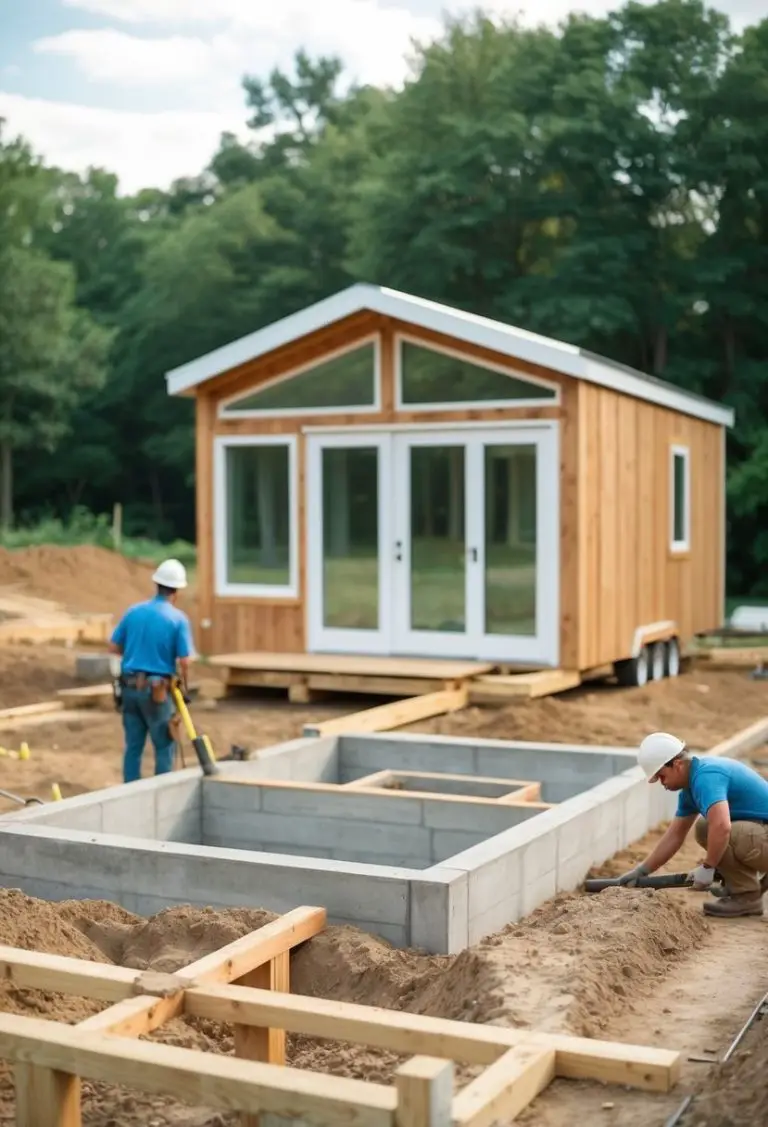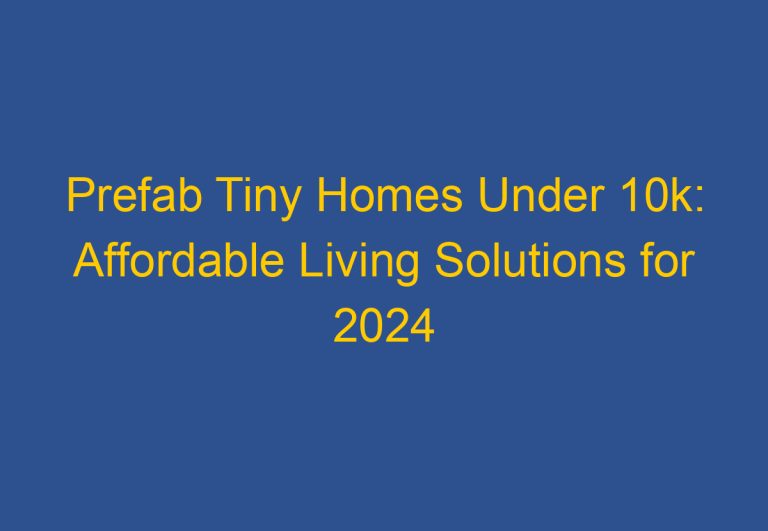Micro Home vs Tiny House: Understanding the Differences
Micro homes and tiny houses are both popular options for those looking to downsize and live a minimalist lifestyle. While the terms are often used interchangeably, there are some key differences between the two.
Micro homes are typically smaller than tiny houses, often measuring under 100 square feet. They are designed to be fully functional living spaces, with a bathroom, kitchen, and bedroom all in one compact area. Tiny houses, on the other hand, can range from 100 to 400 square feet and often have separate rooms for sleeping, cooking, and living.
One of the main advantages of both micro homes and tiny houses is their affordability. With housing costs on the rise, many people are turning to these small homes as a more affordable alternative to traditional housing. Additionally, the tiny house movement has gained popularity in recent years, with many people embracing the idea of living with less and simplifying their lives.
Defining Micro Homes and Tiny Houses
Micro homes and tiny houses are two types of small dwellings that have become increasingly popular in recent years. While they share some similarities, there are also significant differences between them. In this section, we will define micro homes and tiny houses and explore some of the key differences between them.
Size and Space Considerations
One of the main differences between micro homes and tiny houses is their size. Micro homes are generally smaller than tiny houses, with most being under 100 square feet in size. Tiny houses, on the other hand, can range from 100 to 400 square feet in size. This means that tiny houses offer more space and are often more suitable for people who need more room.
In terms of space considerations, tiny houses are often built on trailers, which means that they can be easily moved from one location to another. Micro homes, on the other hand, are often built on foundations and are more permanent structures. This means that tiny houses offer more flexibility in terms of where you can live and travel.
Design and Amenities
Another key difference between micro homes and tiny houses is their design and amenities. Tiny houses are often designed to be as functional as possible, with every inch of space being used to maximum effect. This means that tiny houses often have clever storage solutions and multi-functional furniture.
In terms of amenities, tiny houses often offer more than micro homes. Many tiny houses have a kitchen, bathroom, and living area, as well as other features like lofts, skylights, and outdoor spaces. Micro homes, on the other hand, may not have all of these amenities, and may be more basic in terms of their design.
Overall, micro homes and tiny houses are both small dwellings that offer a range of benefits. Micro homes are more affordable and easier to construct, while tiny houses offer more space and amenities. When choosing between the two, it’s important to consider your specific needs and lifestyle to determine which option is right for you.
Costs and Affordability
When it comes to choosing between a micro home and a tiny house, costs and affordability are major considerations. Here, we break down the costs associated with both options to help you make an informed decision.
Initial Construction and Materials
One of the most significant differences between micro homes and tiny houses is the construction and materials used. Micro homes typically use more affordable materials, such as recycled or repurposed materials, to keep costs low. On the other hand, tiny houses often use high-quality materials, such as cedar or redwood, which can drive up the cost of construction.
The cost of initial construction for a micro home can range from $10,000 to $40,000, while a tiny house can cost anywhere from $20,000 to $100,000 depending on the size and materials used. It’s important to note that the cost of construction can vary greatly depending on the location and availability of materials.
Maintenance and Utility Costs
Another cost consideration is maintenance and utility costs. Micro homes are often more economical in terms of maintenance and utility costs due to their smaller size. They require less energy to heat and cool and have fewer appliances, which can save on utility bills.
Tiny houses, on the other hand, can have higher maintenance and utility costs due to their larger size and more amenities. For example, a tiny house may require a larger heating and cooling system, which can increase energy costs. Additionally, tiny houses often require more frequent maintenance due to their higher-quality materials.
Cost Comparison with Traditional Homes
When comparing the cost of a micro home or tiny house to a traditional home, the affordability factor is clear. Micro homes and tiny houses are often more affordable options for those on a limited budget. They can be a great option for those who want to own a home without taking on a large mortgage.
Overall, both micro homes and tiny houses can be affordable options for those looking to downsize or own a home on a limited budget. However, it’s important to consider all of the costs associated with each option before making a decision.
Lifestyle and Environmental Impact
Sustainability and Eco-Friendliness
One of the biggest advantages of micro homes and tiny houses is their smaller footprint. These homes use less energy and resources than traditional homes, making them more sustainable and eco-friendly. They are also often built with environmentally friendly materials, such as reclaimed wood and recycled materials, which further reduces their carbon footprint.
In addition, micro homes and tiny houses often have more energy-efficient features, such as solar panels and composting toilets, which help to further reduce their environmental impact. These features help to make these homes more sustainable and eco-friendly than traditional homes.
Mobility and Location Flexibility
Another advantage of micro homes and tiny houses is their mobility and location flexibility. These homes can be built on wheels, allowing them to be easily moved from one location to another. This allows homeowners to live a more mobile lifestyle, traveling and exploring new places without having to give up the comforts of home.
In addition, micro homes and tiny houses can be built in a variety of locations, including urban areas and rural areas. This gives homeowners greater flexibility in choosing where they want to live, and allows them to live closer to work, family, or other important amenities.
Overall, micro homes and tiny houses offer a more sustainable and eco-friendly lifestyle, as well as greater flexibility and mobility. These homes are a great option for those who want to live a simpler, more environmentally conscious lifestyle, and who value the freedom to travel and explore new places.
Legal and Social Considerations
Zoning Laws and Placement
One of the biggest challenges facing micro homes and tiny houses is zoning laws and placement. Zoning laws are regulations that govern land use, and they can vary widely from city to city. In some areas, it may be illegal to build a tiny house or micro home on residential land, while in others, they may be allowed but only in certain areas.
When it comes to placement, the size of the home is a major factor. Micro homes, which are typically under 100 square feet, may be easier to place in urban areas, while tiny houses, which can be up to 400 square feet, may require more land space. It is important to research the zoning laws and regulations in your area before deciding to build or purchase a micro home or tiny house.
Community and Social Factors
Community and social factors are also important to consider when it comes to micro homes and tiny houses. In some areas, there may be a strong community of tiny house enthusiasts who can offer support and advice. However, in other areas, there may be resistance to these types of homes, particularly if they are seen as a threat to property values or the character of the neighborhood.
Additionally, micro homes and tiny houses may be seen as a solution to affordable housing or homelessness. However, it is important to note that not all micro homes and tiny houses are designed for these purposes, and there may be legal and social challenges to using them in this way.
In summary, zoning laws and placement, as well as community and social factors, are important considerations when it comes to micro homes and tiny houses. It is important to research and understand the regulations and attitudes in your area before deciding to build or purchase a micro home or tiny house.
Frequently Asked Questions
What are the typical cost differences between micro homes and tiny houses?
The cost of a micro home and a tiny house can vary greatly depending on the size, location, and materials used. Generally, micro homes are more affordable than tiny houses due to their smaller size and simpler designs. However, the cost of building or purchasing a tiny house can vary widely depending on the level of customization and amenities desired.
How do building codes vary for micro homes and tiny houses in states like Florida and California?
Building codes for micro homes and tiny houses vary by state and even by county. In some states, such as California and Florida, there are specific building codes for tiny houses, while in other states, they may fall under the same regulations as recreational vehicles. It is important to research the building codes in your area before beginning construction on a micro home or tiny house.
What size specifications generally define a micro home compared to a tiny house?
A micro home is generally considered to be any home that is 400 square feet or less, while a tiny house is typically defined as anything between 100 and 400 square feet. However, these are not hard and fast rules, and the size of a micro home or tiny house may vary depending on the builder or designer.
Are there financial advantages to purchasing a pre-built tiny home versus a build-it-yourself kit?
There may be financial advantages to purchasing a pre-built tiny home, as it can save time and money on construction costs. However, building a tiny house from a kit can be a more affordable option for those who are handy and have the time and skills to complete the project themselves.
What are the design and amenity differences between micro homes and tiny houses?
Micro homes and tiny houses both offer unique design and amenity options. Micro homes may have more traditional home features, such as a full kitchen and bathroom, while tiny houses may have more creative and space-saving designs, such as lofted sleeping areas and fold-out furniture. The design and amenity options will depend on the builder or designer.
How does the resale value of micro homes compare to that of tiny houses?
The resale value of micro homes and tiny houses can vary widely depending on the location, condition, and amenities of the home. Generally, tiny houses may have a higher resale value due to their unique design and novelty factor. However, the resale value of both micro homes and tiny houses may be affected by the fluctuating housing market and other economic factors.












